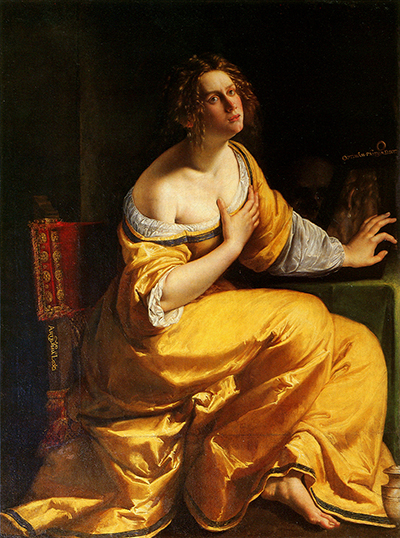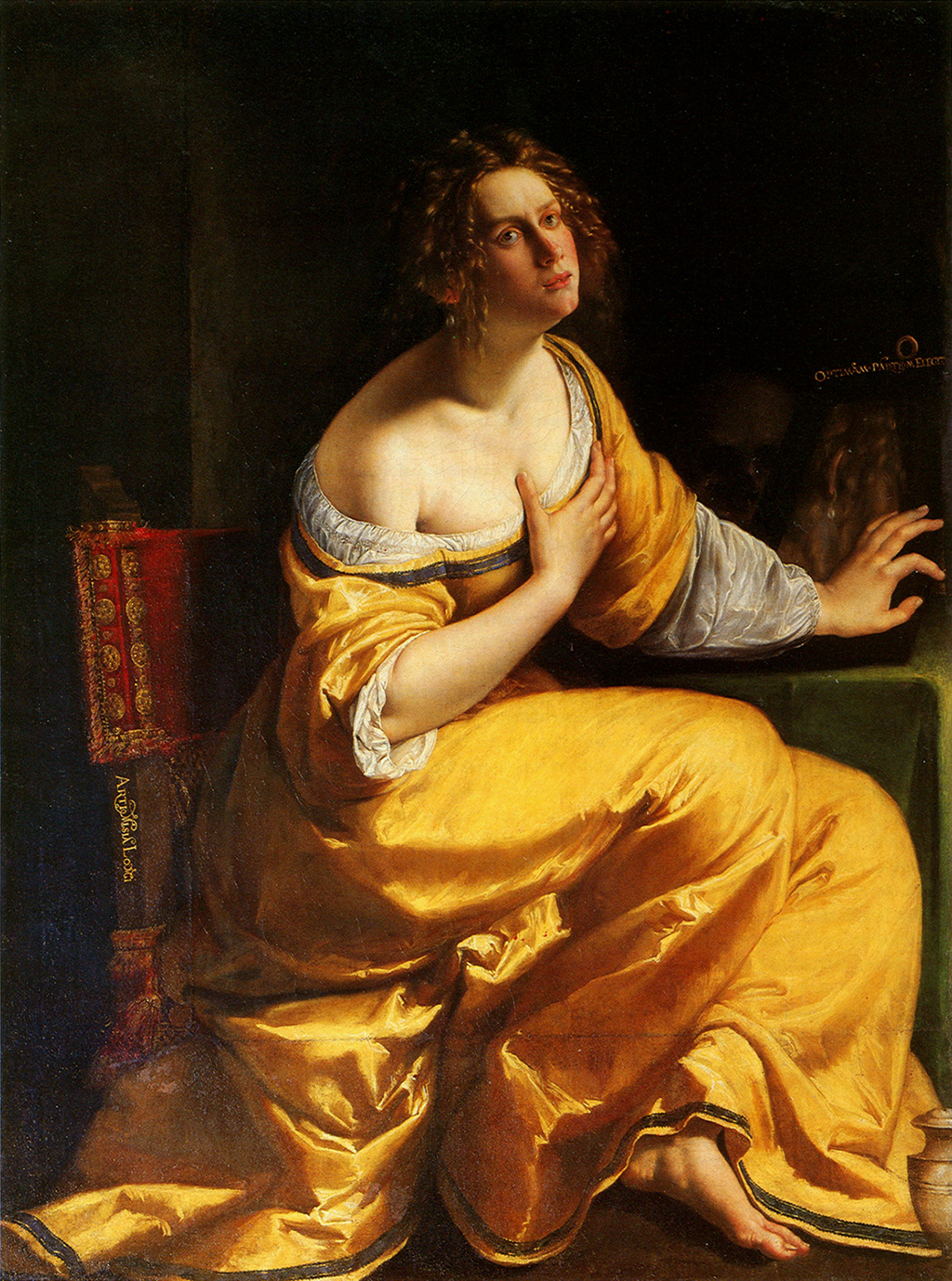Artemisia Gentileschi produced a number of portraits of Mary Magdalene, with this portrait being amongst the most famous and also technically impressive. The artist would have been in her mid-twenties at the time that she produced this work.
The highlight of this painting would have to be the sweeping drapery which immediately captures your focus. It dominates the bottom half of the canvas, with bright tones of yellow plus embroidered touches of black and white. One of her feet just appears from underneath. The chair that she sits on is also beautifully finished, with enough light exposed to it in order for us to see it. There appears to be a dark red material covering the chair, seemingly a soft finish that would be particularly comfortable to sit on. There is also some writing scribed into the part of the chair where the wood is exposed. Her dress hangs low, revealing some cleavage. Mary looks particularly troubled, with her left hand stretched out in desperation. Her eyes bulge out and her cheeks are particularly red. Her right hand covers her chest, perhaps suggesting that she was suffering shock or deep sadness. This iconic figure would feature several times within Gentileschi's career and she was someone who loved to focus on feminine icons within her work, perhaps sometimes connecting her own life to theirs.
This figure has obviously appeared in a number of careers from the Renaissance and Baroque period, but female artists were always able to add a different perspective which would interest many collectors who sought new ideas and techniques to add to their collections. She will always remain a true icon for feminists and also one of the most famous female artists of all time, which is a niche that is starting to receive the attention that it deserves. In recent years there has been a concerted effort to get more of these women featured within exhibitions and permanent displays in order to offer visitors a more diverse selection of work. It is very hard today to alter permanent collections quickly because most famous artists have their work locked down and unavailable for sale, making exhibitions of loaned items a more sensible option. As the spearhead of female artists from more traditional artistic periods, Gentileschi's paintings have been in the most demand as a result of these changes, but that makes extensive displays of her work hard to put together.
This painting from 1616-1618 can be found at the Pitti Palace, Florence. The artist also created Penitent Magdalene too. Her focus on the female body and mind was directly influenced by her own gender and she was able to bring a new perspective to topics that had been covered in the Renaissance and Baroque periods previously. Her ability to connect directly with the mind of each figure and to then deliver emotion at a level that no other artist had managed to achieve would immediately set her out as being unique. Her technical ability was also second to none, and would even scare her father with the rate of progress at which she developed as a teenager. Some of her earlier work was actually mis-attributed to Orazio because of the artistic maturity that she delivered from an early age, as including the painting found in front of us here. She would sometimes work alongside other artists, putting together different elements in whichever each specialised in, such as landscapes or portraits, for example. Eventually this artist would desire to complete each and every part of the scene and ultimately develop her skills in order to be able to do so.
The Pitti Palace, Florence is an outstanding venue which sits within extensive grounds that have been developed and extended over the last few centuries. The gallery contains a series of rooms which are adorned with some of the most important artworks in European history, with a particular focus on the Renaissance and Baroque movements. You will find a number of Antonio Canova sculptures here, for example, as well as a number of Titian paintings, all within the Room of Venus. Within the Room of Saturn you will discover some outstanding paintings by Raphael such a Madonna of the Chair and Portrait of Cardinal Inghirami. Additionally, there are also works from the likes of Peter Paul Rubens, Andrea del Sarto and Caravaggio as well (Sleeping Cupid, Fra Antonio Martelli). Florence is seen by many as the most important city in the construction of the Renaissance period and therefore it is essential that the region remains so well served by institutions such as this, which also possess impressive architectural design and flourishing gardens in order to offer a truly rounded and deep experience to its many thousands of visitors each year.





